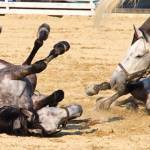Understanding Equine Enteroliths to Minimize Colic

Causes of colic vary dramatically depending on geography. Large enteroliths—stones in the intestinal tract—reportedly make up approximately 25% of the surgical colic caseload at the University of California, Davis. Interestingly, colic due to enterolithiasis in the eastern United States occurs only rarely.
“One specific type of enterolith, called a struvite enterolith, contains magnesium, nitrogen, and phosphorus. These stones form in the intestinal tract and begin with a small foreign object, such as an ingested pebble or rock fragment, that forms the nidus or point of origin of the stone,” Kathleen Crandell, Ph.D., a nutritionist for Kentucky Equine Research described.
Under the “right” conditions, struvite crystals form around the nidus, increasing the size of the stone layer by layer. If an enterolith is sliced in half, the layers of mineral would resemble the concentric rings of a tree stump.
Examples of conditions that appear to encourage the formation of struvite enteroliths include:
- Diets high in magnesium, nitrogen, and phosphorus, which are the main minerals making up struvite crystals;
- A genetic predisposition related to breed (e.g., Arabians);
- High pH of colonic fluids; and
- The mineral content of the horse’s water supply.
According to a recently published study*, diets high in protein should be avoided in horses at risk of enterolith formation, including Arabians and other horses with a history of enteroliths. High-protein diets provide excessive nitrogen to horses, and nitrogen is a major component of enteroliths.
“Excess magnesium should also be avoided because this mineral contributes to a more basic pH in the colon, which favors enterolith formation,” added Crandell. “Magnesium-rich soils yield hay high in magnesium, and even natural water sources can have high levels of this mineral.”
Phosphorus, another important mineral in struvite enteroliths, can be found in high levels in wheat and flaxseed. Certain flax-based feeds may also contribute to this problem and should be avoided in at-risk animals.
Other studies show that other trace minerals can also become trapped in the crystals, such as manganese, iron, zinc, copper, and nickel.
“Having your hay analyzed and a consulting with an KER nutrition advisor will help ensure your horse receives a diet balanced in minerals to help avoid the development of enteroliths,” advised Crandell.
*Rouff, A.A., G.A. Lager, D. Arrue, et al. 2018. Trace elements in struvite equine enteroliths: Concentration, speciation and influence of diet. Journal of Trace Elements in Medicine and Biology. 45:23-30.








